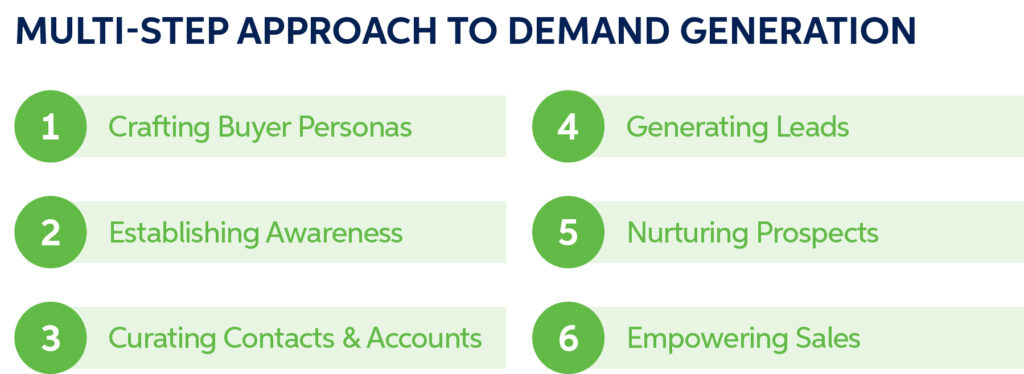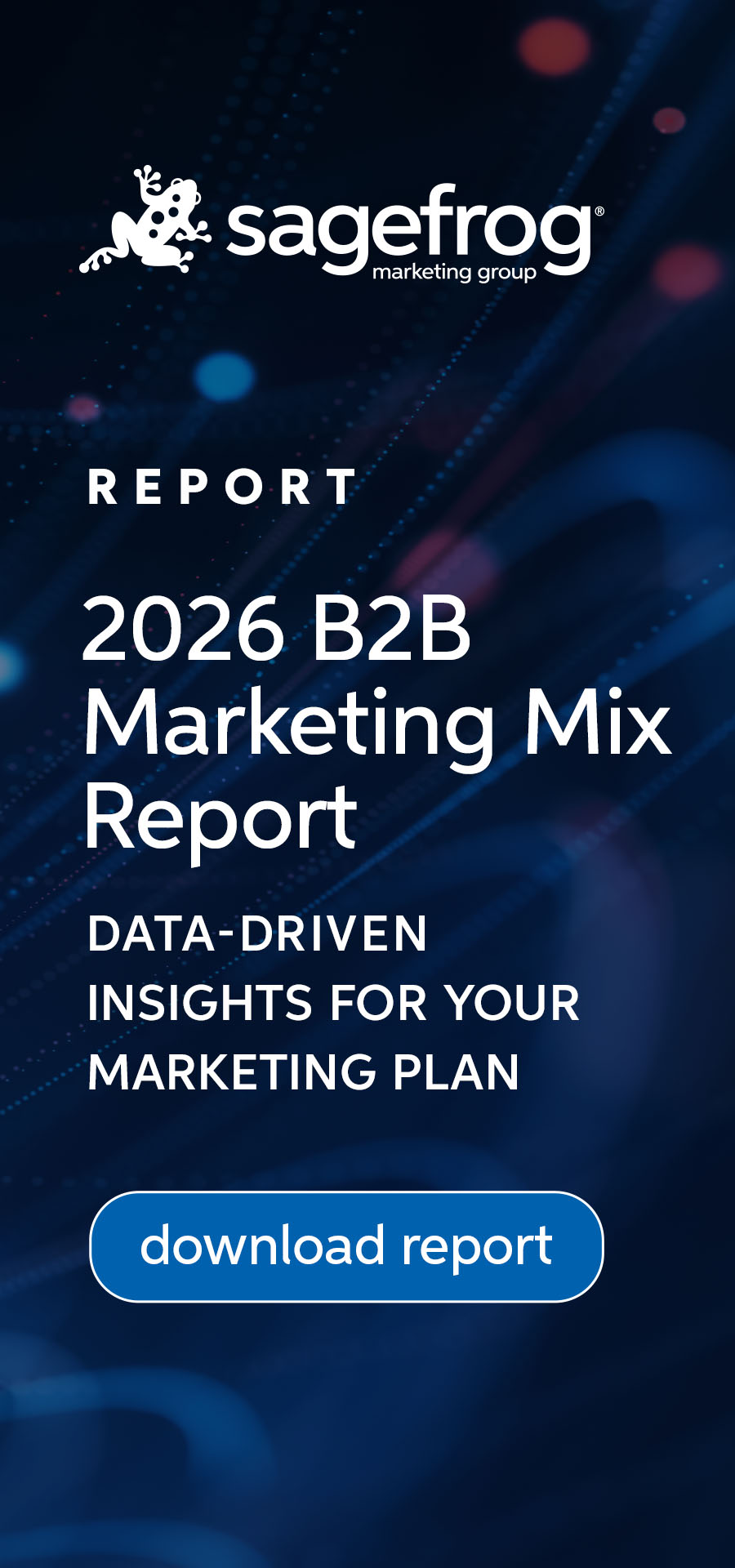With a constant inundation of marketing messages, it’s no surprise that capturing your audience’s attention has never been more challenging—or critical. Businesses aren’t just competing for sales; they’re vying for trust, recognition, and loyalty in a crowded digital landscape. Demand generation has become essential for companies looking to stand out. It’s not just another marketing buzzword; it’s a dynamic, multi-faceted approach to building brand awareness, sparking interest, and creating meaningful connections with your audience. When done well, demand generation doesn’t just fill your pipeline; it positions your business as a trusted leader and problem-solver in your industry, creating lasting impact and sustainable growth.
What Is B2B Demand Generation?
At its core, B2B demand generation is about planting the seeds of interest and nurturing them into meaningful engagement. It’s both a science and an art—a calculated strategy that thrives on genuine connection. Unlike traditional marketing efforts that focus solely on immediate lead acquisition, demand generation is about building a relationship with your audience and meeting them where they are in their buyer’s journey.
B2B demand generation works best when backed by a shared vision between sales and marketing teams, actionable insights from robust analytics, and a deep understanding of what makes your audience tick.
Lead Generation vs. Demand Generation: What’s the Difference?
It’s easy to blur the lines between lead generation and demand generation. While both are vital to a marketing strategy, their goals and approaches differ. The distinction lies in how they serve your audience and your team.
Lead generation is about capturing contact information, often through gated content like whitepapers or webinars. Transactional in nature, it can be thought of as a direct exchange: you offer something of value, and in return, you get the data your sales team needs to start a conversation.
Demand generation, however, casts a wider net. It’s about creating awareness and sparking curiosity before asking prospects for their contact details. Think of it as the foundation—educating your audience, building trust, and positioning your company as the go-to solution. This means using tactics like thought leadership articles, ungated content, and brand-building campaigns to engage your audience and position your company as an industry leader. When your audience is ready to share their information, they’re already invested in your brand and its ability to deliver value.
B2B Demand Generation Funnel
The B2B demand generation funnel represents the stages that a potential customer goes through, from initial awareness to conversion.
Top of Funnel (Awareness)
At the awareness stage, prospects discover your brand through educational blog posts, social media content, or targeted ads that speak to your audience’s pain points and needs—even if they aren’t actively seeking a solution. The focus here is on increasing visibility and building trust rather than on immediate sales.
Middle of Funnel (Consideration)
In the consideration stage, prospects explore and evaluate their options to find the best solution. Case studies, email campaigns, and webinars are powerful tools to engage them and showcase how your offerings meet their needs.
Bottom of Funnel (Decision)
In the decision stage, prospects are ready to make a purchasing decision. Offering free trials, consultations, or demos can provide the final reassurance they need to choose your solution and convert from a prospect to a customer.
An effective demand generation funnel ensures a smooth progression through these stages, delivering value and building trust at every step.
Crafting an Effective B2B Demand Generation Strategy
A successful demand generation strategy requires more than an assortment of tactics. It starts with a clear understanding of your goals, audience, and prospects’ challenges. By aligning your efforts with their needs, you can create campaigns that inspire action and build lasting loyalty.
To streamline your efforts, consider following a structured, multi-step approach to demand generation. Visualizing your strategy as a series of interconnected steps ensures every action serves a purpose.
Each step of your approach should offer a critical building block—from establishing your audience persona to refining campaigns with analytics—designed to help you connect with prospects at every stage of the buyer’s journey. As you move through the process, maintaining focus on clear goals and consistent messaging will elevate the impact of your demand generation efforts.
Benefits of B2B Demand Generation
Demand generation brings a range of benefits that make it a cornerstone of modern B2B marketing. It helps expand brand awareness by positioning your company as an industry leader, ensuring your name comes to mind first when a need arises. It also attracts higher-quality leads by engaging and nurturing your audience, bringing in prospects who are genuinely interested in your offerings. Additionally, demand generation improves sales efficiency by educating and informing prospects, enabling quicker decisions and shorter sales cycles. Finally, it fosters stronger customer relationships by creating lasting connections built on trust and value.
B2B Demand Generation Campaigns
From content marketing to account-based marketing (ABM), effective demand generation campaigns often use a mix of channels to reach prospects where they are. This could include hosting engaging webinars that provide actionable insights and highlight your expertise, using targeted ads to drive traffic to informative blog posts or resource pages, and creating a blend of gated and ungated content to engage audiences at every stage of their journey. By combining these efforts, you can ensure your campaigns resonate with your audience and guide them toward meaningful action.
B2B Demand Generation Tactics
Successful demand generation relies on a variety of innovative and audience-focused tactics. These include account-based marketing, where tailored campaigns target high-value accounts with personalized messaging. Social media advertising is another effective tool, leveraging platforms like LinkedIn to connect directly with decision-makers. Additionally, content syndication allows you to distribute your resources through trusted third-party channels, expanding your reach to new audiences. Together, these tactics create a well-rounded approach to connecting with your audience and driving demand.
B2B Demand Generation Best Practices
Executing a demand generation strategy is as much about mindset as it is about action. By following these best practices, you can maximize your results:
- Know Your Audience: Conduct detailed research to understand your ideal customers, their pain points, and the channels they trust most.
- Align Sales and Marketing: Ensure teams collaborate seamlessly by sharing goals, metrics, and insights.
- Use Data Wisely: Leverage analytics to monitor campaign performance, identify opportunities, and refine your efforts.
- Create Valuable Content: Offer educational resources, thought leadership, and practical tools that align with your audience’s needs.
Demand generation is not a one-time effort; it’s an ongoing process that evolves with your audience and the market. You can ensure long-term success by staying agile and continuously optimizing your approach.
Ready to fuel your growth with demand generation?
Contact our team today to learn how Sagefrog’s 6-step proven process can help you implement customized demand generation strategies designed to drive sustainable growth for your business.



